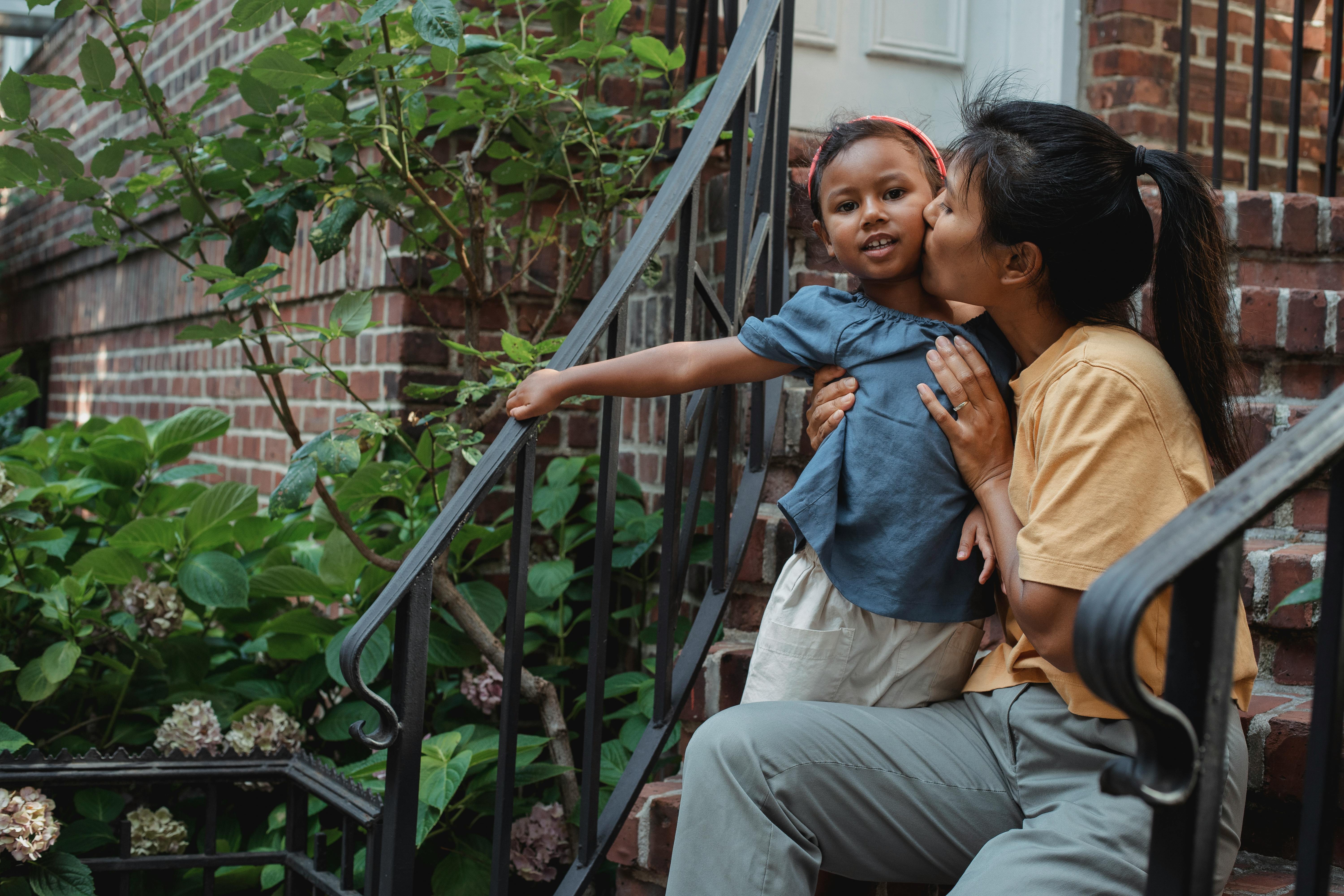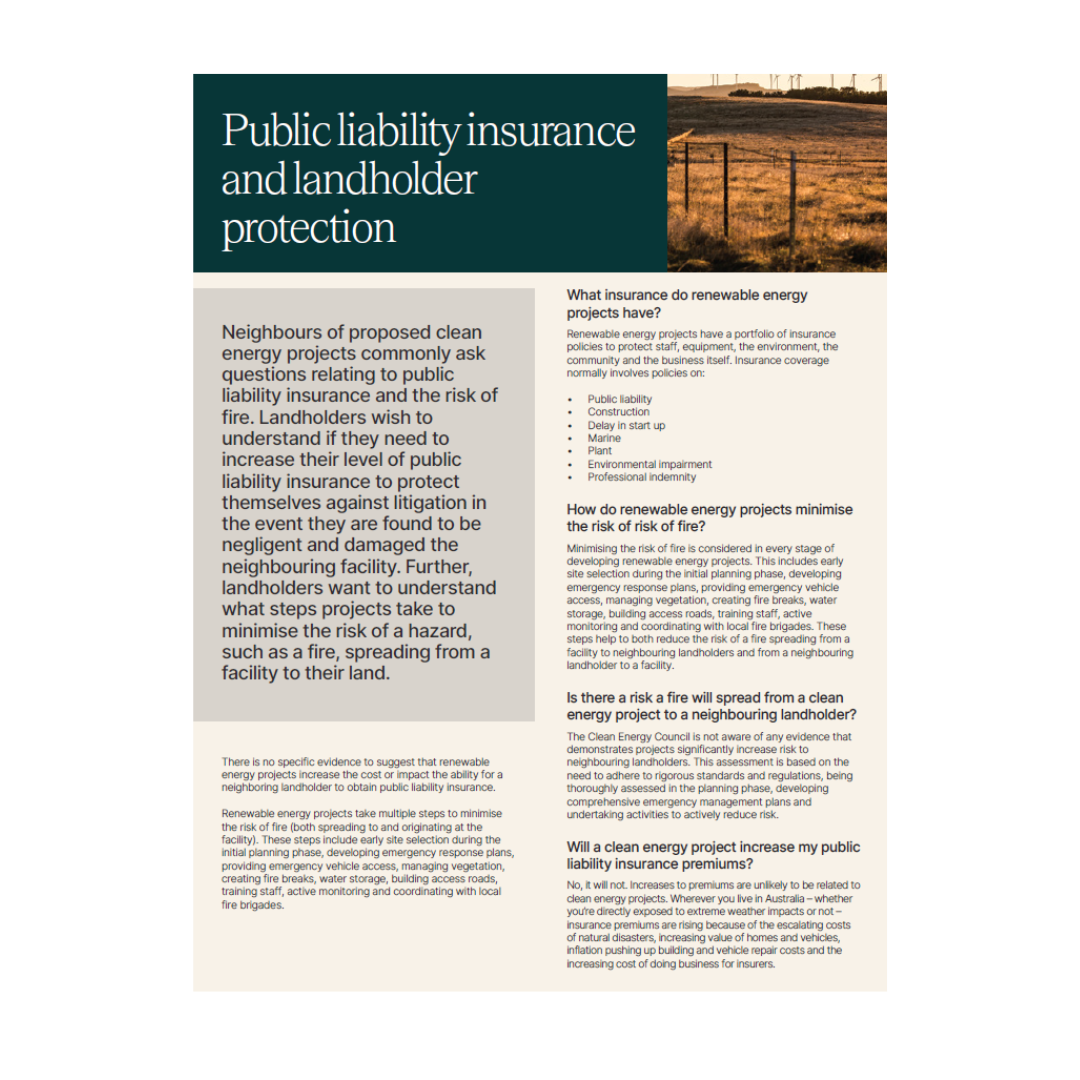Neighbours of proposed clean energy projects commonly ask questions relating to public liability insurance and the risk of fire. Landholders wish to understand if they need to increase their level of public liability insurance to protect themselves against litigation in the event they are found to be negligent and damaged the neighbouring facility. Further, landholders want to understand what steps projects take to minimise the risk of a hazard, such as a fire, spreading from a facility to their land.
There is no specific evidence to suggest that renewable energy projects increase the cost or impact the ability for a neighbouring landholder to obtain public liability insurance. Renewable energy projects take multiple steps to minimise the risk of fire (both spreading to and originating at the facility). These steps include early site selection during the initial planning phase, developing emergency response plans, providing emergency vehicle access, managing vegetation, creating fire breaks, water storage, building access roads, training staff, active monitoring and coordinating with local fire brigades.
What insurance do renewable energy projects have?
Renewable energy projects have a portfolio of insurance policies to protect staff, equipment, the environment, the community and the business itself. Insurance coverage normally involves policies on:
• Public liability
• Construction
• Delay in start up
• Marine
• Plant
• Environmental impairment
• Professional indemnity
How do renewable energy projects minimise the risk of risk of fire?
Minimising the risk of fire is considered in every stage of developing renewable energy projects. This includes early site selection during the initial planning phase, developing emergency response plans, providing emergency vehicle access, managing vegetation, creating fire breaks, water storage, building access roads, training staff, active monitoring and coordinating with local fire brigades. These steps help to both reduce the risk of a fire spreading from a facility to neighbouring landholders and from a neighbouring landholder to a facility.
Is there a risk a fire will spread from a clean energy project to a neighbouring landholder?
The Clean Energy Council is not aware of any evidence that demonstrates projects significantly increase risk to neighbouring landholders. This assessment is based on the need to adhere to rigorous standards and regulations, being thoroughly assessed in the planning phase, developing comprehensive emergency management plans and undertaking activities to actively reduce risk.
Will a clean energy project increase my public liability insurance premiums?
No, it will not. Increases to premiums are unlikely to be related to clean energy projects. Wherever you live in Australia – whether you’re directly exposed to extreme weather impacts or not – insurance premiums are rising because of the escalating costs of natural disasters, increasing value of homes and vehicles, inflation pushing up building and vehicle repair costs and the increasing cost of doing business for insurers.
Wherever you live in Australia - whether you're directly exposed to extreme weather impacts or not - insurance premiums are rising because of the escalating costs of natural disasters
I’m concerned that a renewable energy project that my neighbour is hosting increases my third-party exposure
The clean energy industry is aware of concerns of neighbouring landholders regarding liability and renewable energy projects. Neighbouring landholders do not have a heightened exposure due to a neighbouring renewable energy asset. For example, for an adjoining landowner to have any liability for fires that have spread from their property to a renewable energy project, it must be demonstrated that the landowner was negligent in causing damage. The occurrence of a fire from a weather event (e.g. a lightning strike) that migrates from the landowner property to a neighbouring renewable energy project would not necessarily create a legal liability for the landowner.
How is negligence defined in law?
Negligence is a cornerstone of Australian tort law, governing situations where individuals or businesses fail to exercise reasonable care, resulting in harm to others. Negligence arises when a duty of care is breached, causing harm or damage. Four elements must be established to prove negligence, including duty of care, breach, causation, and damages.
As a landholder, do I have legal obligations or duties to prevent fire?
Depending on which state or territory you live in, you may have legal obligations to prevent bushfires. For example, the NSW Rural Fires Act 1997, section 63, states “It is the duty of the owner or occupier of land to take the notified steps (if any) and any other practicable steps to prevent the occurrence of bush fires on, and to minimise the danger of the spread of bush fires on, or from, that land.”
Fire is part of our unique landscape and like all Australian businesses, clean energy projects have expertise in mitigating this risk.

I need to conduct farming activities during high fire danger periods, what should I do?
The clean energy industry understands that harvesting some specific crops at times of high fire danger is inevitable. Landholders are encouraged to coordinate with neighbouring clean energy projects when there is an increased risk, such as during harvesting or burning of stubble. Renewable energy projects can ensure they have taken steps to protect the facility and that staff are on site to monitor and respond to any issues as they arise. There are also activities landholders can undertake to reduce the risk of fire, such as minimising ignition sources, creating fire breaks and buffer zones, constructing access roads, vegetation management and coordinating with the local fire brigade. Ultimately, landholders are encouraged to reduce risk, speak to their insurance provider and coordinate with the neighbouring clean energy project.
Do renewable energy project developers release neighboring landholders against third-party liability (indemnity)?
It is not standard practice for renewable energy projects to offer release, or a waiver of subrogation (indemnity), to neighboring landholders. A release of liability, or a waiver of subrogation, would likely increase the premiums for the renewable energy project’s own insurance, and could negatively impact the ability for a project’s developer to obtain finance.
Further information
The Insurance Council of Australia has this fact sheet on insurance and renewable energy.
For more information on managing fire risk, see our fact sheet.

